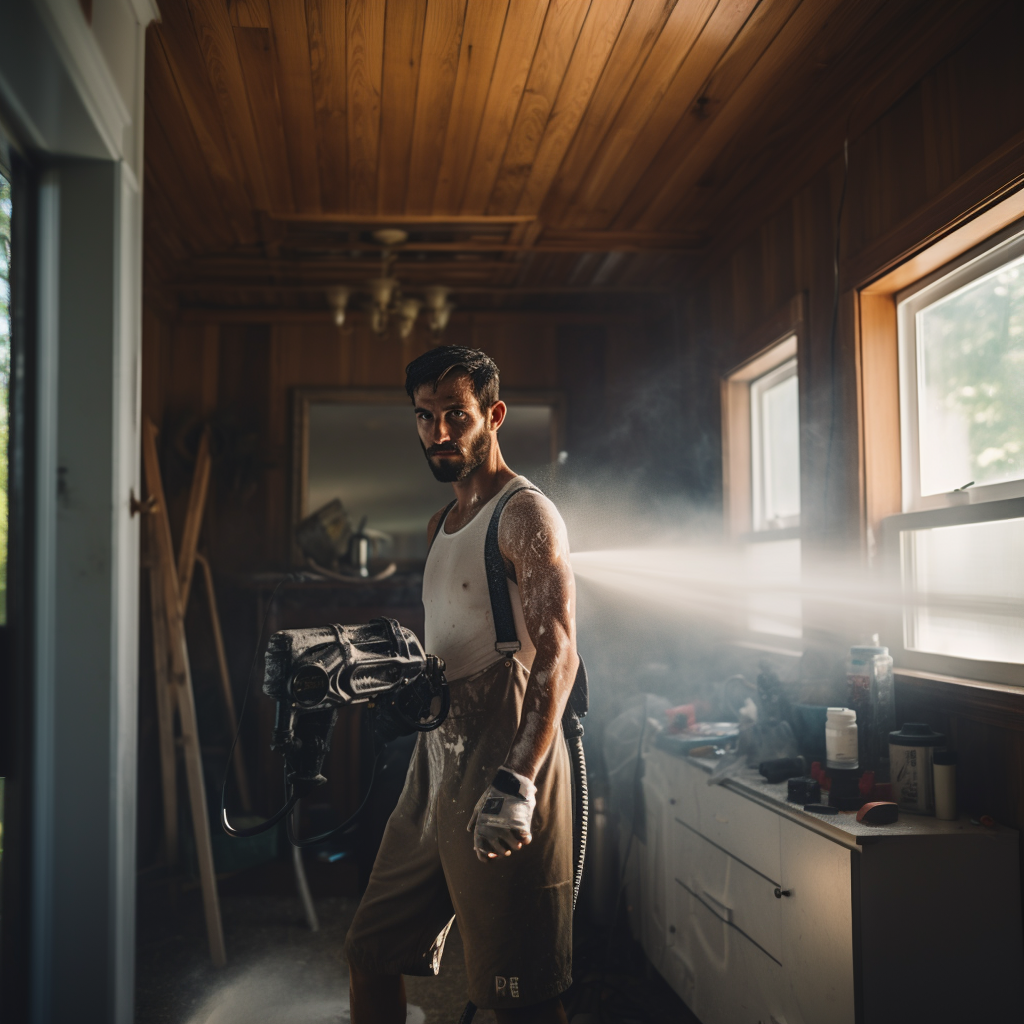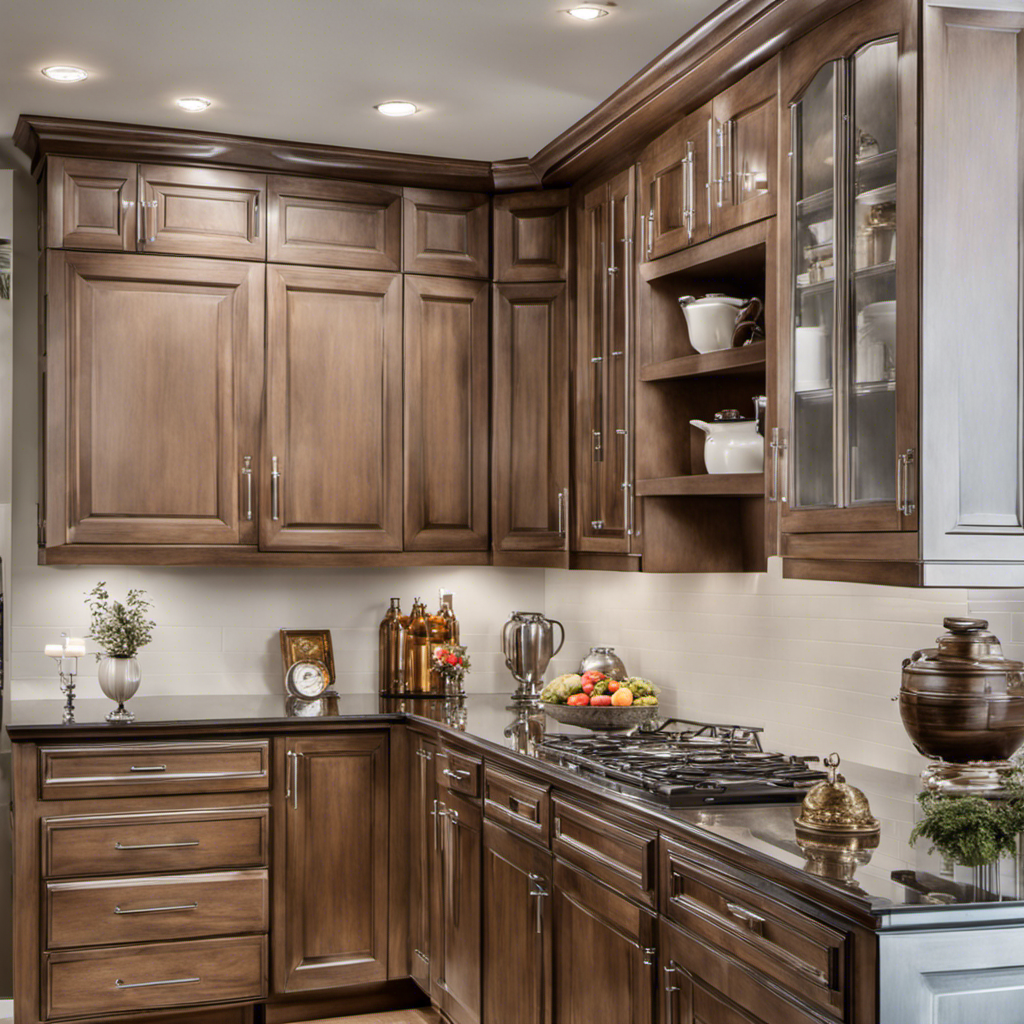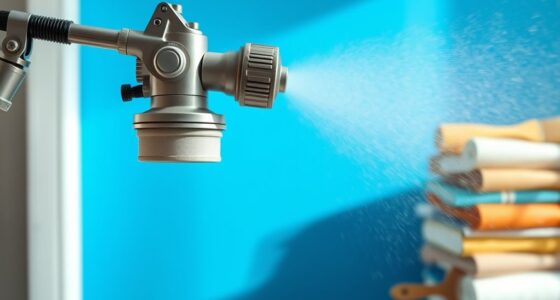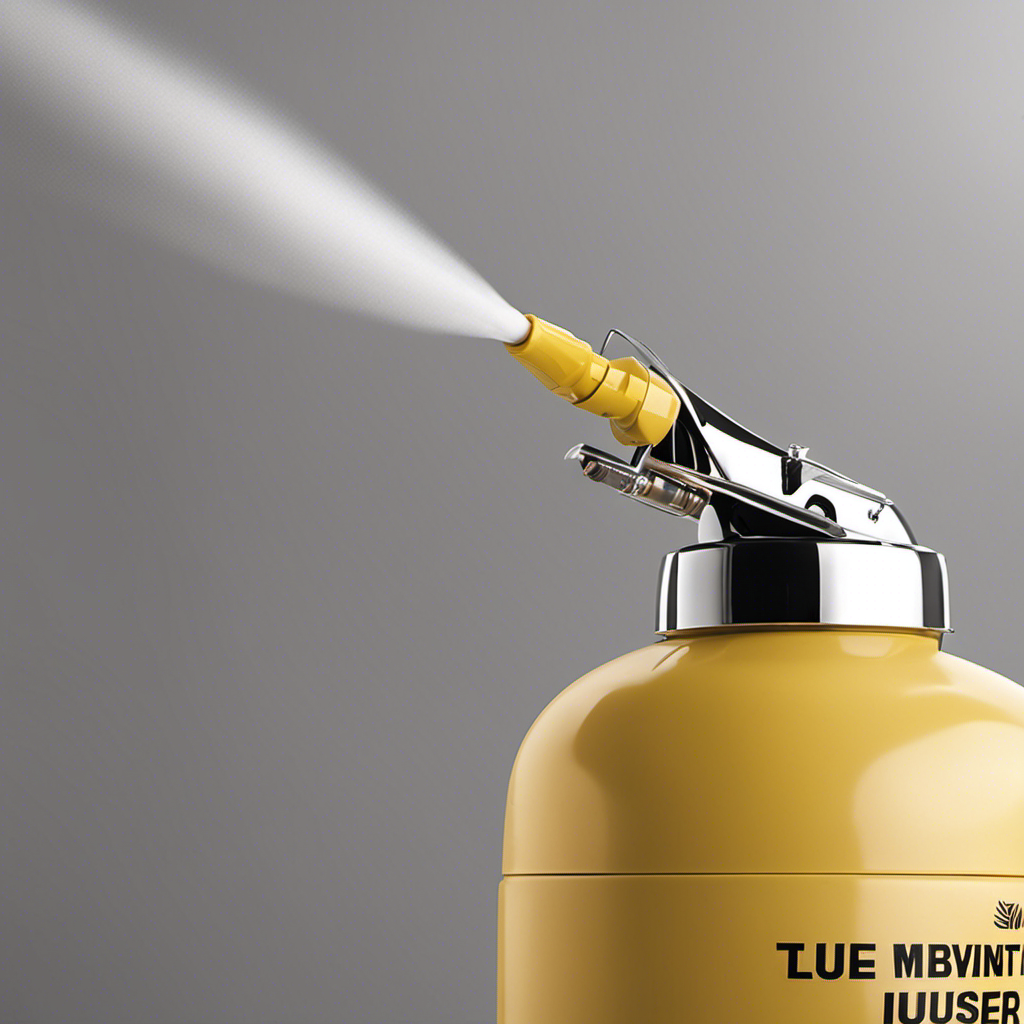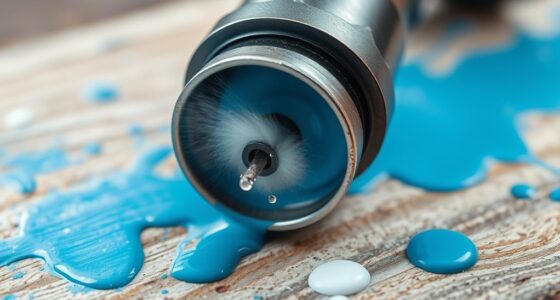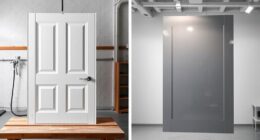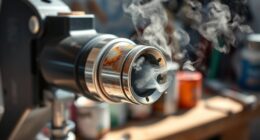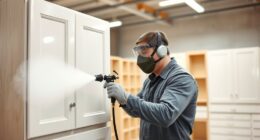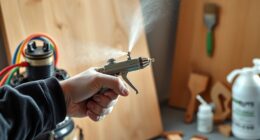The ideal distance to hold your paint sprayer depends on the type you’re using. For airless sprayers, keep it about 12-14 inches from the surface for smooth, even coverage. HVLP sprayers work best at 6-8 inches to prevent runs and overspray. Adjust based on surface texture and paint viscosity, and maintaining a steady distance helps achieve a professional finish. If you want to master the right technique, there’s more to learn below.
Key Takeaways
- Hold HVLP sprayers about 6-8 inches from the surface for optimal control and finish.
- Maintain 12-14 inches distance when using airless sprayers for even coverage.
- Adjust distance based on surface texture: closer for rough surfaces, farther for smooth ones.
- Consider paint viscosity: thicker paints require closer distance, thinner paints can be sprayed from farther away.
- Keep a steady hand and consistent distance to achieve a professional, smooth finish.
Understanding Different Types of Paint Sprayers
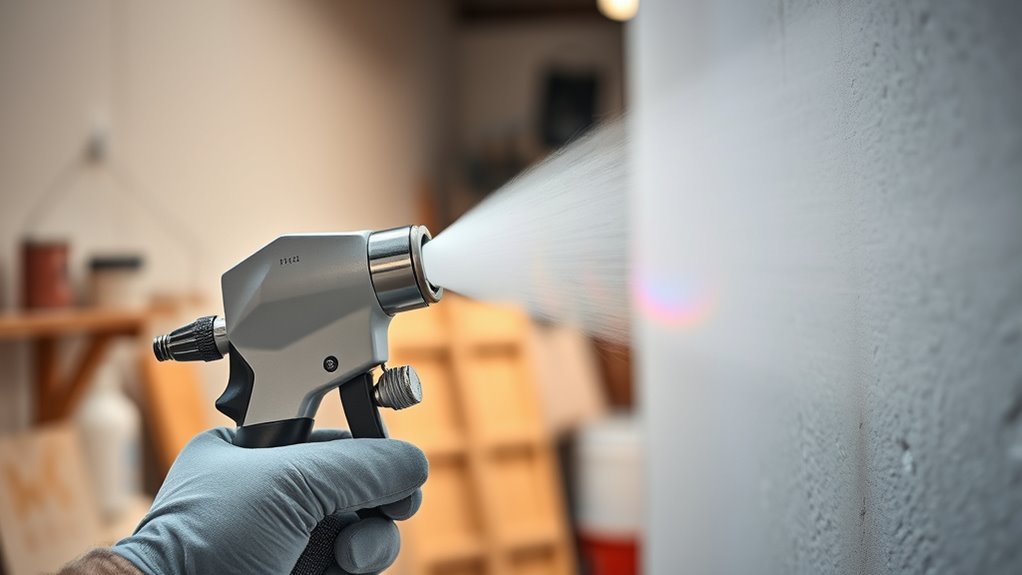
Understanding the different types of paint sprayers is essential for choosing the right tool for your project. Each sprayer type offers unique advantages based on sprayer ergonomics and paint viscosity. For example, HVLP sprayers are designed for better ergonomics, reducing fatigue during extended use, and work best with lower viscosity paints. Conversely, airless sprayers handle thicker paints efficiently, making them ideal for large surfaces. Knowing how sprayer ergonomics impacts comfort helps you select a tool that minimizes strain and maximizes control. Additionally, understanding paint viscosity guides you in choosing equipment that can handle the thickness of your paint without clogging or uneven coverage. Proper spray distance is crucial for achieving an even coat and avoiding paint runs, ensuring smoother application, better finish quality, and easier operation throughout your project. Maintaining the correct spray distance is also important for preventing overspray and ensuring safety during your work.
Factors That Influence Sprayer Distance
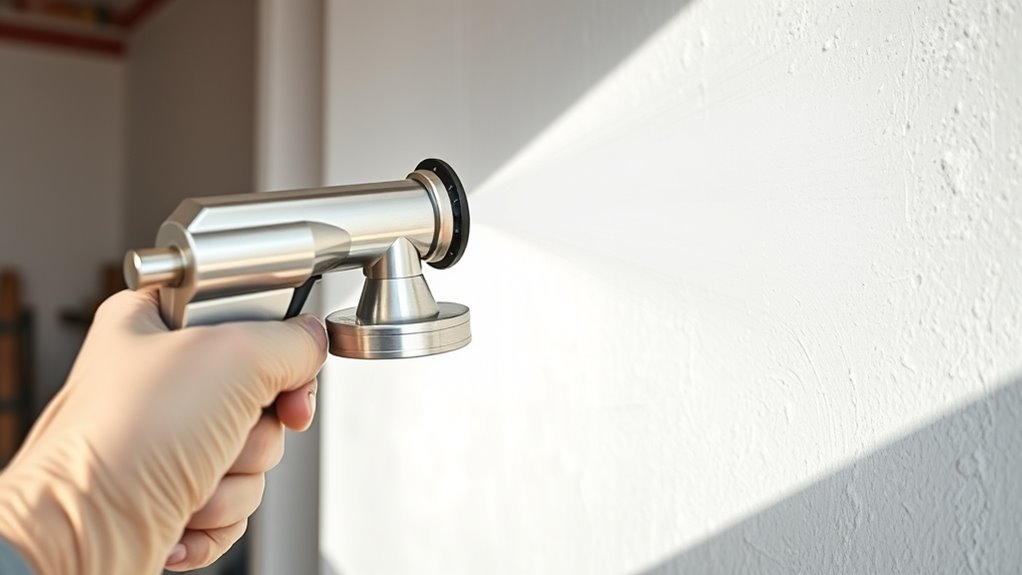
The distance you hold your paint sprayer considerably impacts the quality of your finish and the efficiency of your project. Your spray technique plays a key role; holding the sprayer too close can cause drips and uneven coverage, while holding it too far reduces paint transfer and results in a thinner coat. Factors like spray pattern, paint viscosity, and surface texture also influence the ideal distance. Safety precautions are essential—maintaining the right distance minimizes overspray and inhalation risks. Adjusting your distance based on the type of surface and spray equipment ensures better control and a professional finish. Remember, consistent distance helps you apply an even coat, reducing the need for touch-ups and rework. Additionally, understanding the bedroom environment can help you optimize your spraying technique for interior surfaces. Proper technique and awareness of paint flow are crucial for achieving optimal results and avoiding common issues like runs or dry spray. Monitoring air pressure can also influence the spray pattern and distance effectiveness, ensuring a smoother application. Being aware of protective gear is also vital to safeguard against paint fumes and overspray during the process. Moreover, understanding the Glycolic Acid Benefits for Skin can help you maintain healthy skin after working with paints and chemicals.
Recommended Distance for Airless Spray Guns

For ideal results with airless spray guns, holding the nozzle approximately 12 to 14 inches from the surface is generally recommended. This distance helps guarantee an even coat, minimizes overspray, and promotes efficient surface preparation. Maintaining proper distance also allows you to control the spray pattern, avoid drips, and achieve smooth finishes. Proper surface preparation combined with the right distance makes all the difference. Additionally, understanding how proper distance impacts spray quality can help you achieve professional-looking results. Keeping a consistent distance helps develop digital literacy skills in your painting technique, ensuring accuracy and efficiency. Understanding how technique influences the spray outcome can lead to better control and fewer errors. Recognizing the importance of consistent application can further enhance the overall quality of your work. Here’s a quick visual guide:
| Distance (inches) | Surface Quality | Spray Pattern |
|---|---|---|
| 12-14 | Smooth, even | Uniform |
| Less than 12 | Thicker spray | Blotchy |
| More than 14 | Thin, uneven | Faded |
Furthermore, practicing at this recommended distance can help you build consistency in your application method, which is essential for a professional finish.
Optimal Distance for HVLP Sprayers
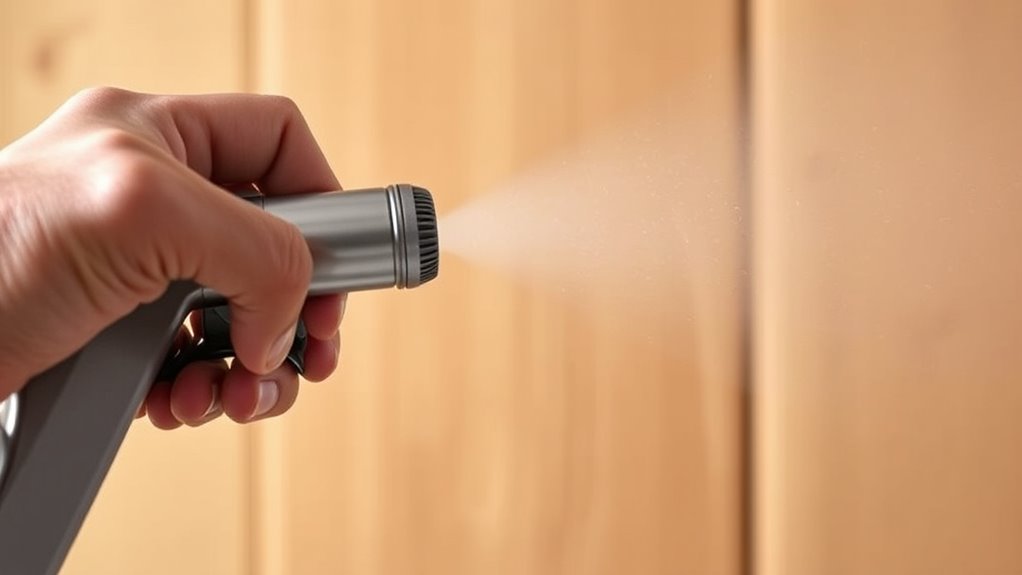
Maintaining the correct distance when using HVLP (High Volume Low Pressure) sprayers is key to achieving a smooth, professional finish. Typically, holding the sprayer about 6 to 8 inches from the surface works well, but this can vary based on spray pressure and nozzle size. Lower spray pressure requires you to hold the sprayer a bit closer to maintain proper coverage, while higher pressure might allow for a slightly greater distance. The nozzle size also influences this; a larger nozzle disperses more paint, so holding the sprayer too close can cause runs or overspray. Generally, starting at around 6 inches and adjusting as needed based on the spray pattern and paint flow will give you the best results. Always test on a scrap piece first. Additionally, understanding the proper spray technique can help improve your results and prevent common issues like drips or uneven coverage. Employing consistent motion during application ensures a uniform coat and minimizes defects. Proper spray distance is crucial for achieving an even and professional finish, especially when working on detailed or large surfaces. To optimize your spray technique, consider the security measures that protect your equipment and data, ensuring safe operation. Being aware of exposure risks and using appropriate protective gear can also enhance safety during spraying.
Adjusting Distance Based on Surface and Paint Type
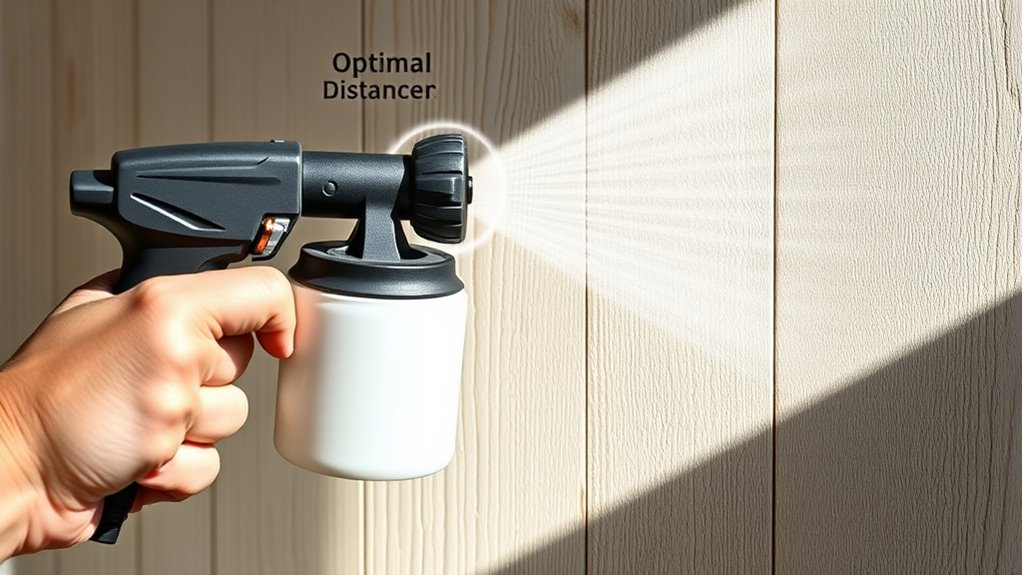
Since different surfaces and paint types react uniquely to spray application, adjusting your distance accordingly can substantially improve your finish, prevent drips, and guarantee even coverage. For rough surfaces like stucco or brick, hold the sprayer closer—about 6-8 inches—to ensure paint reaches crevices. Smooth surfaces, such as drywall or metal, benefit from a slightly farther distance of 10-12 inches to avoid overspray. For thin or fast-drying paints, increase the distance to prevent runs. Incorporate good surface preparation and brush techniques to blend spray layers seamlessly. Remember, the right distance depends on the surface texture and paint consistency. Experiment with small sections first to find the ideal distance, ensuring a professional, even finish. Adjusting the spray technique based on surface and paint type can make a significant difference in the quality of your work. Additionally, understanding painting safety practices can help you achieve the best results while protecting yourself during the process. Recognizing the appropriate spray distance can also help optimize paint transfer efficiency and reduce material waste, especially when considering the paint viscosity and how it influences spray behavior. Properly controlling the paint spray angle can further improve coverage and minimize overspray, leading to a more efficient painting process.
Tips for Achieving Even Coverage and Fine Finish

To achieve an even coverage and a smooth, professional-looking finish, focus on your spray technique and equipment settings. Maintain a consistent spray distance, which helps prevent uneven spots or drips. Use smooth, overlapping strokes, similar to brush techniques, to guarantee uniform application. Additionally, slightly thinning your paint can improve flow and reduce splattering, leading to finer results. Adjust your sprayer’s pressure and nozzle settings for ideal atomization, preventing excessive buildup or dry spray. Practice on scrap surfaces to refine your technique and identify the ideal distance and spray pattern. Consistency is key—move at a steady pace and keep your hand steady. Incorporating visual and auditory cues can aid in developing a more accurate spray technique. Being mindful of equipment maintenance ensures your sprayer operates efficiently and produces quality finishes. Moreover, understanding the AI developments in related fields can inspire innovative approaches to your painting projects. These tips will help you achieve a flawless, even finish with minimal effort.
Frequently Asked Questions
How Does the Spray Pattern Affect Ideal Distance?
The spray pattern directly impacts how far you should hold your paint sprayer for the best application. A wider spray pattern requires holding the sprayer closer to maintain application consistency, while a narrower pattern allows for a slightly greater distance. Adjust your distance based on the spray pattern to guarantee even coverage and avoid drips or uneven layers. Experimenting with your settings helps achieve a smooth, professional finish.
Can Holding the Sprayer Too Close Cause Paint Runs?
Holding your sprayer too close can cause paint runs, and studies show 60% of beginners face this issue. When you’re too near, the spray pattern becomes uneven, compromising spray consistency and paint adhesion. This results in drips and thick spots. Keep the sprayer at an ideal distance—usually 6 to 12 inches—to guarantee smooth, even coverage and better adhesion, avoiding those frustrating runs and achieving professional results.
What Safety Precautions Should I Take When Spraying?
When spraying, always wear safety goggles and a mask to protect your eyes and lungs. Keep the paint nozzle pointed away from your face and others. Adjust the spray pressure to prevent overspray and uneven coats. Make certain the area is well-ventilated, and wear protective clothing. Handling the paint nozzle carefully and maintaining proper spray pressure guarantees safety and a better finish, reducing risks of accidents or inhaling fumes.
How Do Environmental Conditions Influence Spray Distance?
Environmental conditions profoundly influence your spray distance. Wind can blow spray away from the target, so you might need to hold the spray nozzle closer or adjust air pressure to compensate. Humidity and temperature also affect how the paint atomizes and adheres. When spraying outdoors, keep a steady air pressure and maintain a consistent distance from the surface, ensuring the spray pattern stays even despite changing environmental factors.
Is There a Difference in Distance for Indoor Versus Outdoor Projects?
You should hold your paint sprayer at the right distance for indoor and outdoor projects to achieve a smooth finish. Indoors, you might need a closer distance, around 6-12 inches, to control paint thickness and avoid overspray, similar to a consistent brush technique. Outdoors, you can hold it slightly farther to accommodate wind and environmental factors, adjusting for paint viscosity to guarantee even coverage without drips.
Conclusion
To get a flawless finish, keep experimenting with your sprayer distance, much like a seasoned painter from centuries past. Remember, the right distance varies with your sprayer type and surface, so stay attentive and adjust as needed. With patience and practice, you’ll master even coverage and a smooth, professional look. Don’t forget, a steady hand and keen eye are your most valuable tools—just like wielding a brush in the great ateliers of old.
Franz came aboard the Paint Sprayer Zone team with a background in both journalism and home renovation. His articulate writing style, combined with a passion for DIY projects, makes him an invaluable asset. Franz has a knack for breaking down technical jargon into easy-to-understand content, ensuring that even the most novice of readers can grasp the complexities of paint sprayers.


